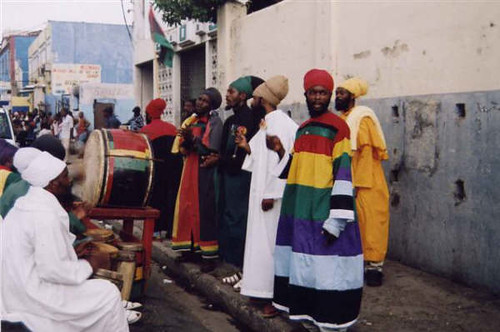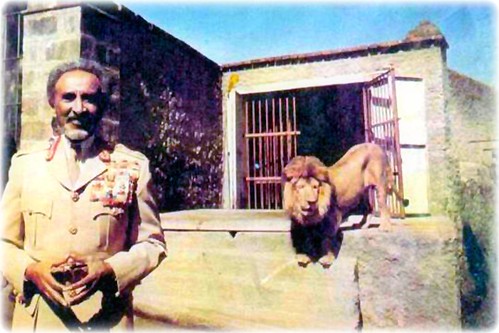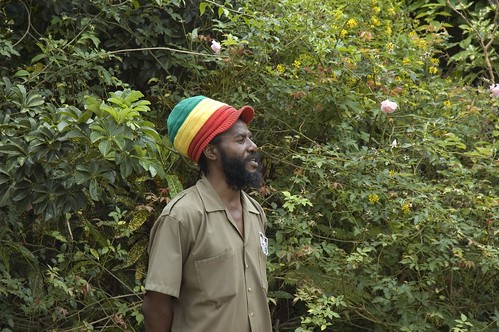 "A system of symbols which acts to establish powerful, pervasive, and long-lasting moods and motivations in men by formulating conceptions of a general order of existence and clothing these conceptions with such an aura of factuality that the moods and motivations seem uniquely realistic". (Geertz definition)
"A system of symbols which acts to establish powerful, pervasive, and long-lasting moods and motivations in men by formulating conceptions of a general order of existence and clothing these conceptions with such an aura of factuality that the moods and motivations seem uniquely realistic". (Geertz definition)The Rastafarian Movement has been expressed to the world through Bob Marley's music, but that is just a preview of the long history the Rastafarian's possess. For years, many misunderstood their way of life and traditions. My goal for this final project, was to visually illuminate the "long-lasting moods and motivations" of the Rastafarian's to better understand their culture.
I've included a picture that I feel sums up some parts of my final project. It includes Marcus Garvey, the Lion of Judah with Haile Selassie, Bob Marley, the flag, and Zion
10.) Rastafarian Formation,Pilgrimage, and Image.
 Redemption Song is a very touching popular song in my opinion for 3 reasons: 1.) this was Marley's last song before his death 2.) The overall message in relation to Marcus Garvey 3.) The song in relation to the Rastafari Movement. The song refers to a lot societal and political issues that have occurred in the past directly effecting black people. "Emancipate yourselves from mental slavery, none but ourselves can free our minds" (Redemption Song)In this song Bob Marley is informing his people that the only way to beat Babylon is to redeem ourselves spiritually, physically and mentally.
Redemption Song is a very touching popular song in my opinion for 3 reasons: 1.) this was Marley's last song before his death 2.) The overall message in relation to Marcus Garvey 3.) The song in relation to the Rastafari Movement. The song refers to a lot societal and political issues that have occurred in the past directly effecting black people. "Emancipate yourselves from mental slavery, none but ourselves can free our minds" (Redemption Song)In this song Bob Marley is informing his people that the only way to beat Babylon is to redeem ourselves spiritually, physically and mentally. 9.) Rastafarian Formation,Pilgrimage, and Image.
 Bob Marley became thee most popular reggae singer and songwriter World Wide. He is known for songs such as: No woman, No Cry, Exodus, I Shot the Sheriff, Get up stand up, and Redemption Song. I would say that Exodus, Get up Stand Up and Redemption Song are the best representations of the Rastafarian system of symbols. The main chorus in Exodus is “Exodus, Movement of Jah people”. The main chorus in Get up Stand up is “get up stand up, stand up for your rights”. Going back to Marcus Garvey, these lyrics represent the African Redemption movement. He’s calling out for his people to recognize the corrupt Babylonian way of living. He wants his people to rise up and become more spiritually in tune so that they might be able to create change in their community and eventually go on their religous journey to Zion in Ethiopia.
Bob Marley became thee most popular reggae singer and songwriter World Wide. He is known for songs such as: No woman, No Cry, Exodus, I Shot the Sheriff, Get up stand up, and Redemption Song. I would say that Exodus, Get up Stand Up and Redemption Song are the best representations of the Rastafarian system of symbols. The main chorus in Exodus is “Exodus, Movement of Jah people”. The main chorus in Get up Stand up is “get up stand up, stand up for your rights”. Going back to Marcus Garvey, these lyrics represent the African Redemption movement. He’s calling out for his people to recognize the corrupt Babylonian way of living. He wants his people to rise up and become more spiritually in tune so that they might be able to create change in their community and eventually go on their religous journey to Zion in Ethiopia. 8.) Rastafarian Formation,Pilgrimage, and Image.
 The Bobo Shanti tribes are the more spiritually developed Rastafarian's.They separate themselves from the rest and, if blessed with the opportunity, they will go up to the mountains in Bull Bay, Jamaica to prepare for their pilgrimage back to Ethiopia through prayer mediation, and other traditions. The term Bobo means black and Ashanti derives from an African tribe in Ghana. Their system of symbols is represented by their clothing. The boboshanti wear long robes and often red turbans to identify themselves. They also post signs around their territory to remind them of their beliefs and to assure justice and reasoning for their pilgrimage. The YouTube video we watched in class is a pretty accurate representation of the Boboshanti. In this video, a man by the name of Ancient talks about the Boboshanti purpose (1:40- 2:15):
The Bobo Shanti tribes are the more spiritually developed Rastafarian's.They separate themselves from the rest and, if blessed with the opportunity, they will go up to the mountains in Bull Bay, Jamaica to prepare for their pilgrimage back to Ethiopia through prayer mediation, and other traditions. The term Bobo means black and Ashanti derives from an African tribe in Ghana. Their system of symbols is represented by their clothing. The boboshanti wear long robes and often red turbans to identify themselves. They also post signs around their territory to remind them of their beliefs and to assure justice and reasoning for their pilgrimage. The YouTube video we watched in class is a pretty accurate representation of the Boboshanti. In this video, a man by the name of Ancient talks about the Boboshanti purpose (1:40- 2:15):7.) Rastafarian Formation,Pilgrimage, and Image.

 This is a picture of Zion. As you can see most are wearing traditional long robes and turbans, I'm not quite sure who these people are but there may be some Bobo Shanti here in this picture.
This is a picture of Zion. As you can see most are wearing traditional long robes and turbans, I'm not quite sure who these people are but there may be some Bobo Shanti here in this picture. This is a picture of the Saint Mary's church in Zion.
This is a picture of the Saint Mary's church in Zion. Zion is the “ultimate paradise” for the Rastafarian's. The most spiritually developed Rastafarian's take their pilgrimage to Zion to seek unity and spiritual oneness with Jah.
6.) Rastafarian Formation,Pilgrimage, and Image.
 The Lion of Judah represents Hailee Selassie.The Lion is often shown with Selassie and/or the Ethiopian Flag (green, red and yellow or gold, and sometimes black). I watched this YouTube video a while back and this Rastafarian Man referred to Selassie as “King of Kings, Lord of Lords, Conquering of the Tribe of Judah, Selassie”. This represents the powerful religious figure that he is for the Rastafarian's. Selassie has no biblical recognition, yet the Rastafarian's believe that he does.
The Lion of Judah represents Hailee Selassie.The Lion is often shown with Selassie and/or the Ethiopian Flag (green, red and yellow or gold, and sometimes black). I watched this YouTube video a while back and this Rastafarian Man referred to Selassie as “King of Kings, Lord of Lords, Conquering of the Tribe of Judah, Selassie”. This represents the powerful religious figure that he is for the Rastafarian's. Selassie has no biblical recognition, yet the Rastafarian's believe that he does. Ive included a picture of Emperor Halie Selassie and a lion.
4&5.) Rastafarian Formation,Pilgrimage, and Image.


The Rastafarian's even created their own English dialect also known as Iyaric. The Rastafarian's did not believe in the use of negative vocabulary. The use of negative or belittling vocabulary was a part of the Babylonian society. For emample: The use of me and my are replaced with I; “I man”. I represents their oneness with Jah or God. This is an important part of their system of symbols, separating themselves from society.
5.) Dreadlocks, another Rastafarian symbol, are now a hair style amongst popular culture. There are many theories as to why they are called “dreads” or “dreadlocks”. The one that seems most reasonable in terms of the Rastafari movement would be the Europeans expressing their dreadful feeling towards the hairstyle. The Rastas took this term and flipped it from having a negative connotation to a more positive one embracing their distinctiveness.
No comments:
Post a Comment